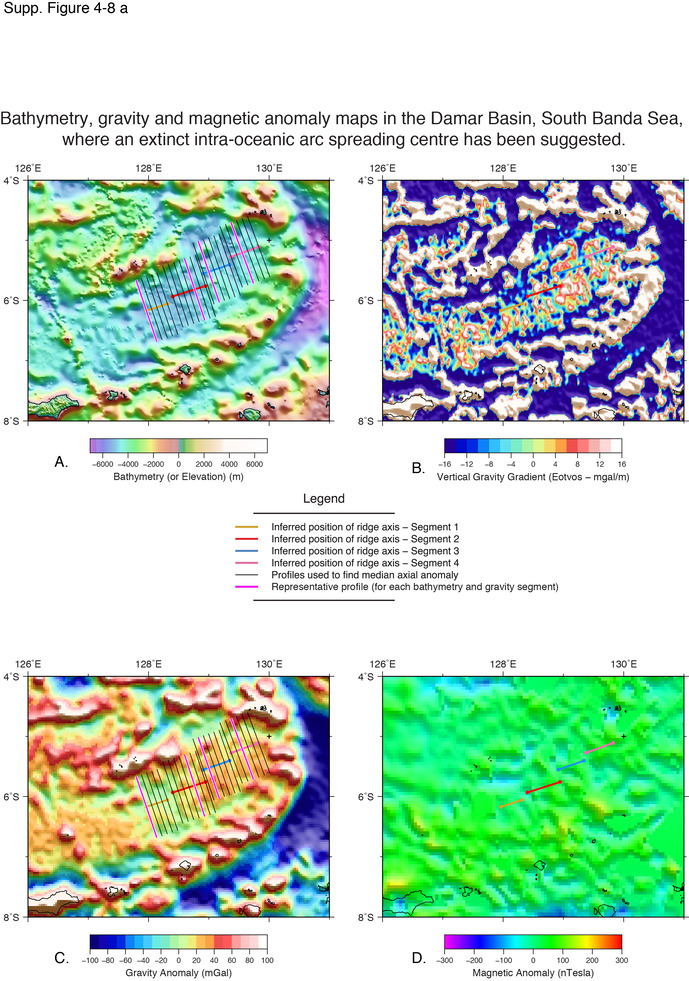| Ocean: | Marginal basin |
| Spreading center type: | Intra-oceanic spreading center |
| Time of cessation: | Ca. 3 Ma, chron C2An3n (Hinschberger et al., 2001)) |
| Subsequent active spreading center: | None in immediate area |
| Later deformation or volcanism: | A present-day active strike-slip fault is argued to be present at the west of the Damar basin and colcanism was reported in the Neogene at the Lucipara ridge to the north of the basin (Honthaas et al., 1998). |
The Damar Basin is situated in the east of the South Banda Sea, which is bounded by Timor to the south, New Guinea to the east and Sulawesi to the northwest (Hinschenberger et al., 2001). This region is tectonically complex and is characterized by numerous microplates and migratory subduction zones with related volcanic arcs that present significant difficulties for regional tectonic reconstructions (Zahirovic et al., 2014). This discussion is limited to review of the specific studies that have proposed an extinct ridge within the Damar Basin (Hinschberger et al., 2001).
Geochronological studies have constrained the age of the Nieuwerkerk-Emperor-Lucipara and Banda volcanic arcs to the north and south of the Damar Basin to 10 Myrs and younger (Honthaas et al., 1998). These dates support the age of the Damar backarc basin proposed by Hamilton (1979), who synthesized existing geological and geophysical data available at that time. Even after the study of Honthaas et al. (1998) there remains significant controversy regarding the age of the basin, which given its depth and low heat flow had been predicted to be over 60 Myrs old (Hinschberger et al., 2001). Mesozoic, M-series magnetic anomalies had been identified in previous studies, with Hinschberger et al. (2001) reporting that a previous study (Karta, 1985, unpublished Ph.D. thesis that was not available for this review) identified an M0 age extinct ridge to the south of the Banda ridges that are found in the north of the Damar basin.
Hinschberger et al. (2001) reviewed geophysical data collected over numerous marine surveys within the South Banda Sea and identified symmetric magnetic anomalies from the Neogene. The spreading center was interpreted as a fossil intra-arc basin, sandwiched between two volcanic arcs above opposite polarity subduction zones to the north and south. The short spreading system is segmented and a paleo-spreading rate of 30 mm/yr is estimated from magnetic anomaly identifications.
It is argued that spreading center ceased when the Inner Banda volcanic arc to the south, collided with the Australian continental block (Hinschberger et al., 2001).
The Damar Basin is situated in the east of the South Banda Sea, bounded by Timor to the south, New Guinea to the east and Sulawesi to the NorthWest. The inferred axial segments of the extinct ridge do not exhibit the characteristic morphology or gravity signal of the others we review in our study, although an extinct ridge is suggested by magnetic anomaly identifications (Hinschberger et al., 2001). The lack of a clear axial bathymetric or gravity anomalies could be a character of extinct intra-oceanic spreading centers, given that this was the only intraoceanic basin spreading ridge that we are aware has been reported.
Hamilton, W., 1979, Tectonics of the Indonesian region, USGS Professional Paper, 1078. 345 pp.
Hinschberger, F., Malod, J.A., Dyment, J., Honthaas, C., Réhault, J.P. and Burhanuddin, S., 2001, Magnetic lineations constraints for the back-arc opening of the Late Neogene South Banda Basin (eastern Indonesia) Pacific Irian Jaya Eurasian Indo-Australian plate, Tectonophysics, v. 333, p. 47–59.
Honthaas, C., Réhault, J.P., Maury, R.C., Bellon, H., Hémond, C., Malod, J.A., Cornée, J.J., Villeneuve, M., Cotten, J., Burhanuddin, S. and Guillou, H., 1998, A Neogene back-arc origin for the Banda Sea basins: Geochemical and geochronological constraints from the Banda ridges (East Indonesia), Tectonophysics, v. 298, p. 297–317.
Zahrovic, S. E., Seton, M., and Müller, R. D., 2014, The Cretaceous and Cenozoic tectonic evolution of Southeast Asia, Solid Earth, doi: 10.5194/se-5-227-2014.


